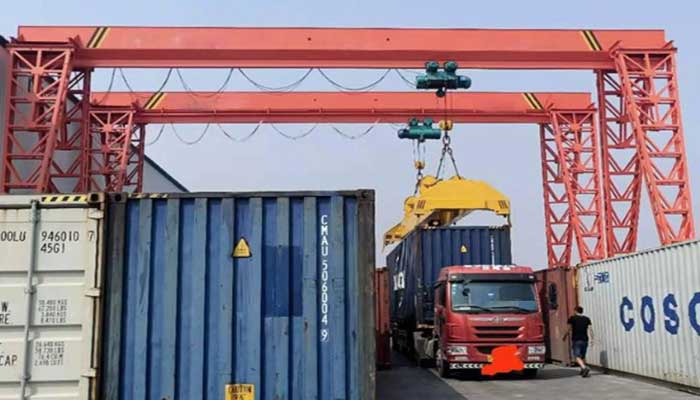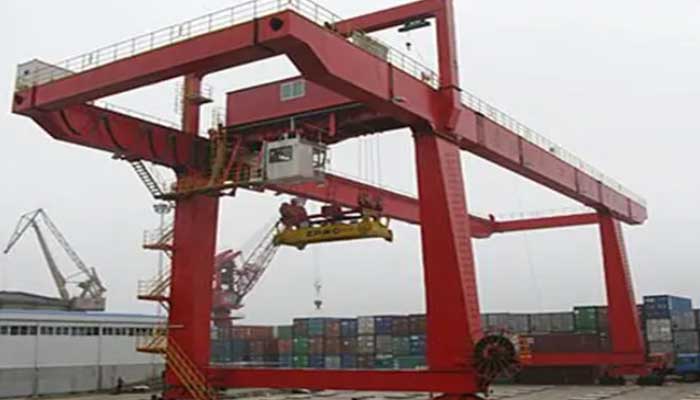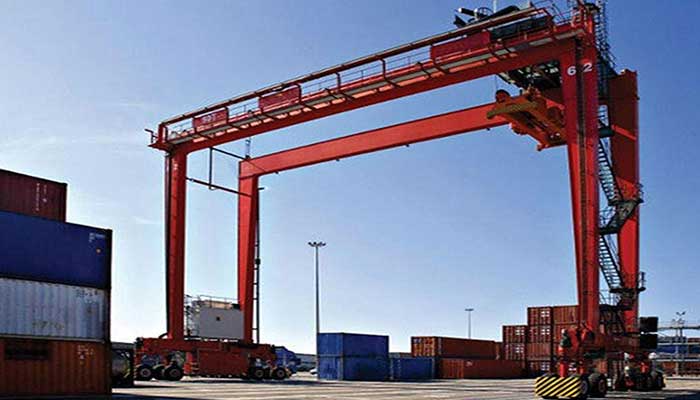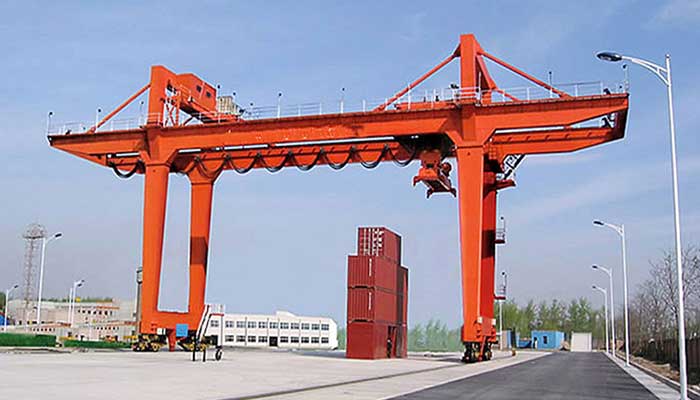Rail-Mounted Container Gantry Cranes, Custom Gantry Crane for You
Rail-Mounted Container Gantry Cranes, Unlocking Efficiency and Precision
At its core, a Rail-Mounted Container Gantry Crane is a specialized material handling system designed explicitly for efficiently moving containers within ports, terminals, and logistical hubs. Unlike traditional cranes, RMGs are uniquely mounted on railway tracks, providing them with a remarkable degree of mobility and accuracy.
These cranes are engineered with a sophisticated array of components meticulously assembled to streamline the handling of shipping containers. Consisting of a sturdy steel structure, hoisting machinery, spreader beams, and an intricate system of electrical and control mechanisms, the RMG stands as a testament to precision engineering.
Central to the RMG's functionality is its ability to traverse along parallel rails, allowing seamless movement across vast cargo yards or storage areas. The crane's hoisting mechanism, powered by electric motors, facilitates the vertical movement of containers, enabling efficient loading and unloading operations.
The spreader beam, a pivotal component, acts as the interface between the crane and the containers. This beam securely grasps the containers, ensuring safe and swift handling while maintaining stability throughout the process.
The synchronization of electrical and control systems governs the crane's every motion, enabling precise positioning and efficient workflow. This intricate orchestration of components and mechanisms defines the RMG's prowess in the realm of cargo handling.
Types of Rail-Mounted Container Gantry Cranes
Diving deeper into the realm of Rail-Mounted Container Gantry Cranes (RMGs), it's crucial to understand the various types that exist, each tailored to specific operational needs and environments.
Single Beam vs. Double Beam Rail-Mounted Container Gantry Cranes One of the primary distinctions among RMGs lies in their structural design: single beam and double beam configurations.
Single girder container gantry crane with A frame Gantry design
Single beam RMGs feature a simplified structure, utilizing a single horizontal beam for lifting operations. They are adept at handling moderate loads and are often employed in smaller-scale terminals or facilities with space limitations.
double girder rail mounted contaciner gantry crane for sale , u frame container gantry cranes
On the other hand, double beam RMGs boast a more robust design, incorporating two horizontal beams. This design offers increased lifting capacities and enhanced stability, making them the preferred choice for handling heavier loads and operating in high-volume container terminals.
Rubber-Tired vs. Rail-Mounted Gantry Cranes

Conversely, rail-mounted gantry cranes, as the name suggests, operate along fixed rails, offering exceptional precision and control in container movement. Their structured track-based system ensures consistent and accurate container positioning, making them indispensable in container terminals where precise handling and placement are paramount.
Understanding the nuances between these types of RMGs is pivotal in selecting the optimal crane configuration that aligns with specific operational requirements and facility constraints.
Features, Benefits, and Typical Applications of Each Type
As we navigate through the world of Rail-Mounted Container Gantry Cranes (RMGs), it's crucial to uncover the distinct features, advantages, and specific applications that define each type, shaping their relevance across diverse industrial landscapes.
Single Beam RMG: Features, Advantages, and Specific Applications
Features: Single beam RMGs, with their simplified structure, excel in agility and ease of maintenance. They are characterized by their efficient use of space and are adept at handling moderate container loads.
Advantages: The compact design of single beam RMGs makes them suitable for terminals with limited space. Their lower initial investment and operational costs also make them an attractive choice for smaller-scale operations seeking reliable container handling solutions.
Specific Applications: Single beam RMGs find their niche in smaller ports, terminals, and logistics centers where moderate container handling capacities are sufficient. Their flexibility and cost-effectiveness make them an ideal choice for facilities looking to streamline operations without compromising on efficiency.
Double Beam RMG: Features, Benefits, and Common Usage
Features: The robust dual-beam structure of double beam RMGs ensures superior load-bearing capabilities and enhanced stability. These cranes are designed for handling heavier container loads with precision and reliability.
Benefits: With higher lifting capacities and improved stability, double beam RMGs are indispensable in high-volume container terminals where rapid and efficient handling of heavy loads is essential. Their structural integrity enables seamless operations, contributing to increased throughput and reduced downtime.
Common Usage: Double beam RMGs are the cornerstone of large-scale container terminals and ports where the demand for handling heavy containers is prevalent. Their exceptional lifting prowess and stability make them the go-to choice for facilities dealing with extensive cargo volumes.
Comparison between Rubber-Tired and Rail-Mounted Gantry Cranes
Rubber-Tired Gantry Cranes (RTGs), with their mobility and adaptability, thrive in intermodal yards and facilities requiring versatile handling capabilities. Their rubber tires enable flexibility in movement, making them suitable for navigating various terrains and layouts.
Rail-Mounted Gantry Cranes (RMGs), operating on fixed rails, ensure precise and consistent container positioning. They are the preferred choice for container terminals demanding accuracy and efficiency in container handling operations.
Industrial Applications of Rail-Mounted Container Gantry Crane
In the realm of material handling and logistics, Rail-Mounted Container Gantry Cranes (RMGs) stand as indispensable assets, revolutionizing cargo handling operations across diverse industrial sectors. Let's delve into the multifaceted applications of these engineering marvels:
Port Operations and Container Terminals
Port operations form the nucleus of RMG utilization. Container terminals, bustling hubs of international trade, rely heavily on RMGs for seamless container handling. These cranes efficiently load and unload containers from vessels, precisely stacking them in yards for storage or further transportation. Their precision and speed play a pivotal role in optimizing port productivity and ensuring smooth cargo flow, contributing significantly to global trade logistics.
Warehousing and Logistics Centers
Beyond port operations, Rail-Mounted Container Gantry Cranes find their footing in warehousing and logistics centers. These cranes streamline container movement within these facilities, facilitating efficient storage, retrieval, and transportation of goods. They enable the swift transfer of containers between storage areas and transportation mediums, ensuring the seamless functioning of supply chains.
Manufacturing and Heavy Industry
The application scope of RMGs extends to manufacturing and heavy industries where the need for efficient material handling is paramount. These cranes aid in handling raw materials, finished products, and oversized components within manufacturing plants and heavy industrial facilities. Their precision and load-bearing capabilities streamline production processes, optimizing workflow and enhancing overall productivity.
The versatility and adaptability of Rail-Mounted Container Gantry Cranes across various industrial sectors underscore their significance as a linchpin in the realm of material handling and logistics. Their ability to revolutionize cargo handling operations has positioned them as an indispensable asset in optimizing efficiency and productivity across multiple industries.

rail mounted container gantry crane
Top Concerns of Rail-Mounted Container Gantry Crane Users
As users and potential purchasers of Rail-Mounted Container Gantry Cranes (RMGs), understanding and addressing crucial concerns are paramount to ensure safe, efficient, and productive operations. Here are the key focal points:
Safety Measures and Operational Guidelines
Safety stands as the foremost concern in any industrial setting, and RMG operations are no exception. Ensuring stringent adherence to safety protocols and operational guidelines is imperative. This includes comprehensive training for crane operators, implementation of safety features, regular inspections, and the establishment of clear operational procedures. Emphasizing a safety-first approach not only protects personnel but also safeguards the integrity of the cargo handling process.
Maintenance and Downtime Management
Efficient maintenance routines are critical in maximizing RMG uptime and longevity. Scheduled maintenance, timely inspections, and swift repairs are pivotal in minimizing unplanned downtime. Establishing a proactive maintenance schedule tailored to the specific needs of the crane ensures optimal performance and mitigates the risk of unexpected breakdowns. Swiftly addressing any issues that arise helps maintain the crane's operational efficiency.
Efficiency and Productivity Enhancement
Enhancing efficiency and productivity are perpetual goals in the realm of RMG operations. Optimizing workflow, streamlining container handling processes, and deploying advanced technologies such as automation and predictive maintenance systems play a pivotal role in achieving these objectives. Constant evaluation and implementation of innovative solutions are essential to keep pace with evolving industry demands and drive operational excellence.
FAQ: Answers to Common Questions on Rail-Mounted Container Gantry Crane
Understanding the nuances and functionalities of Rail-Mounted Container Gantry Cranes (RMGs) often raises several pertinent questions. Here are answers to some of the frequently asked queries:
How does an RMG differ from other types of cranes?
RMGs distinguish themselves from other cranes, such as overhead cranes or mobile cranes, primarily through their specialized design and operational scope. Unlike mobile cranes, RMGs operate along fixed rails, enabling precise container movement in port terminals and warehouses. While overhead cranes have a different design, often used in factories for lifting and transporting heavy loads within a limited area, RMGs are specifically tailored for container handling in logistics and port operations.
What are the key maintenance requirements for an RMG?
Maintenance is vital to the optimal functioning and longevity of RMGs. Key maintenance requirements include regular inspections of critical components such as hoisting mechanisms, spreader beams, electrical systems, and structural integrity checks. Lubrication of moving parts, cleaning of electrical systems, and adherence to a proactive maintenance schedule are essential to prevent breakdowns and ensure smooth operations. Moreover, conducting routine safety checks and promptly addressing any identified issues is pivotal in maintaining peak performance.
Can an RMG be customized for specific operational needs?
Yes, RMGs can be customized to meet specific operational requirements. Manufacturers often offer customization options tailored to varying load capacities, container sizes, and terminal layouts. Customizations can include alterations in lifting capacity, span width adjustments, specialized spreader attachments, or the integration of advanced control systems for improved efficiency. Discussing specific operational needs with the manufacturer or supplier allows for tailored solutions that align precisely with the facility's requirements.
Get Your Custom Rail-Mounted Container Gantry Crane
RMGs stand as pillars of efficiency, precision, and reliability in the world of cargo handling. Their benefits, ranging from precise container positioning to enhanced productivity, have found applications across various industrial sectors. In ports and terminals, they streamline container movements, optimizing cargo flow and facilitating international trade. Moreover, in warehousing, logistics centers, manufacturing, and heavy industries, their versatility fosters seamless material handling, bolstering operational efficiency.
Future Trends and Innovations in RMG Technology
The landscape of RMG technology continues to evolve, driven by a pursuit of enhanced efficiency and technological advancements. Future trends indicate a shift towards greater automation, incorporating artificial intelligence and machine learning for predictive maintenance and improved operational decision-making. Integration of IoT (Internet of Things) sensors for real-time monitoring, eco-friendly energy solutions, and advancements in crane control systems are poised to redefine the capabilities and functionalities of RMGs in the coming years.
As RMG manufacturers and suppliers continue to innovate, the focus remains on developing smarter, more efficient, and environmentally sustainable solutions. These advancements are not just about technological evolution but are geared towards addressing the evolving needs of industries and ensuring seamless, safe, and optimized cargo handling operations.
In conclusion, Rail-Mounted Container Gantry Cranes stand as epitomes of innovation and efficiency, driving the wheels of global trade and supply chain logistics. Embracing their capabilities and understanding their potential for customization and technological integration is pivotal for businesses seeking to optimize their material handling operations and stay ahead in the dynamic landscape of logistics and industrial operations.




